An unpretentious and unpretentious variety that requires minimal care - the Tolstushka tomato: we grow it without hassle
The Fat Tomato was bred specifically for regions with an unfavorable climate. It has established itself as a high-yielding variety that is immune to many diseases. Agricultural technology throughout the growing season is so simple that every beginner who wants to grow a tomato with excellent taste on their plot can cope with it.
Characteristics and description of the variety
The Tolstushka variety from the Siberian Garden agricultural firm is intended for regions with harsh climates. It is distinguished by its endurance and adaptability to adverse conditions.
Reference. The Siberian Garden agricultural company has occupied a leading position in the seed sales market for many years.
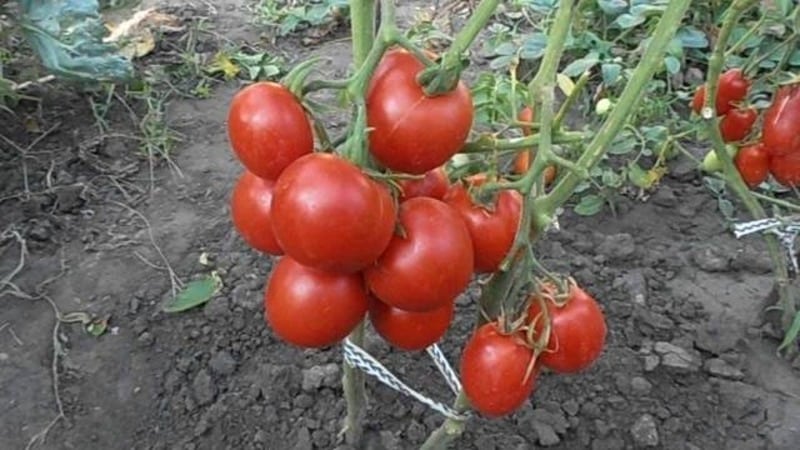
Distinctive features
The bush is determinate, compact, no more than 80 cm high. The stem is strong, the foliage is medium, the leaves are small, dark green. The first cluster is formed after the 9th leaf; each cluster bears 8 fruits. The inflorescences are simple.
A mid-early variety, it takes 115-120 days from planting to full ripening.
Immune to major diseases of the nightshade family. Recommended for cultivation in open ground and in greenhouses.
Productivity is high: up to 7 kg of fruits are harvested from 1 bush, provided that 3-4 seedlings are planted per 1 sq. m. m.
Despite its short growth, the plant requires garter, otherwise the branches will not withstand the weight of ripe fruits. Culture needs stepsoning. For the best quantitative indicator, the bush is formed into 2 stems.
Fruit characteristics
The fruits are large, with an average weight of 200-250 g, flat-round in shape, red in color. The taste is sweet, with barely noticeable sourness, the flesh is juicy, the skin is dense. There are 4 seed chambers, few seeds.
Universal use in cooking: the fruits are well suited for fresh salads and preparations for the winter. Do not lose their taste when processed into tomato products: juices, ketchups, lecho. Smaller tomatoes are used for whole-fruit canning. Tomatoes go well with other vegetables.
They are subject to long-term storage and retain their appearance well during long-term transportation.
The photo shows Tolstushka tomatoes.
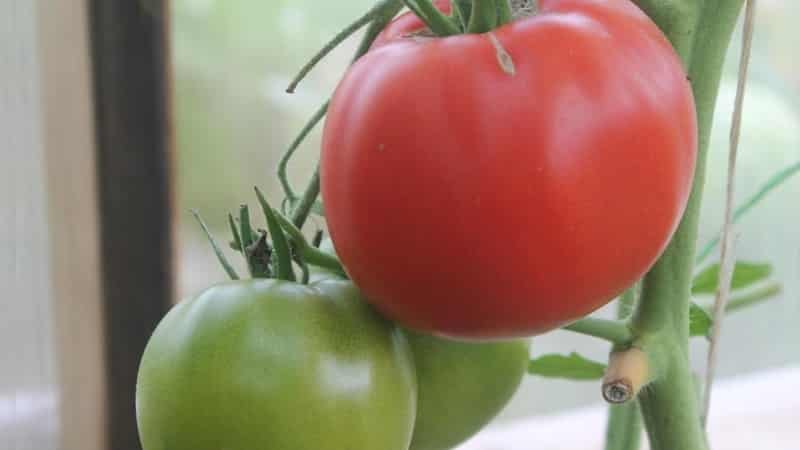
How to grow seedlings
Sowing seeds start 2 months before planting seedlings in the ground. This crop belongs to a hybrid culture, so seeds for planting are purchased each time in specialized stores.
Reference. Seeds of hybrid crops do not retain their parental properties, so independent harvesting for subsequent plantings does not make sense.
Seed preparation
First, the seed is checked for external defects. All seeds should be smooth, light in color and without visible damage. To determine whether the seeds are empty or not, they are dipped in a saline solution. To do this, dissolve 1 teaspoon of salt in 1 glass of water and place it in the grain solution for 10 minutes. Those seeds that float to the surface are not suitable for sowing.
The remaining ones are disinfected in a weak solution potassium permanganate 20 minutes. Then they are washed with running water, wrapped in gauze, slightly moistened and left in a dark and warm place for 3 days, wetting the gauze with warm water as it dries. As soon as the grains sprout, they are sown in the ground.
Reference. To improve germination, seeds are soaked in a growth stimulator for 8-10 hours.
Container and soil
The soil is prepared from garden soil, peat and sawdust in a ratio of 7:1:0.5. For lightness, add a little washed river sand to the soil mixture. After thoroughly mixing all the components, the soil is fertilized with humus or mullein infusion. The resulting soil is laid out in planting containers, in which small holes are made in advance at the bottom so that excess moisture does not retain.
Plant in a common wooden box or individual containers, for example, plastic cups, paper honeycombs and peat pots.
Reference. Peat pots contain a complex of useful substances that nourish the sprouts before planting in the ground.
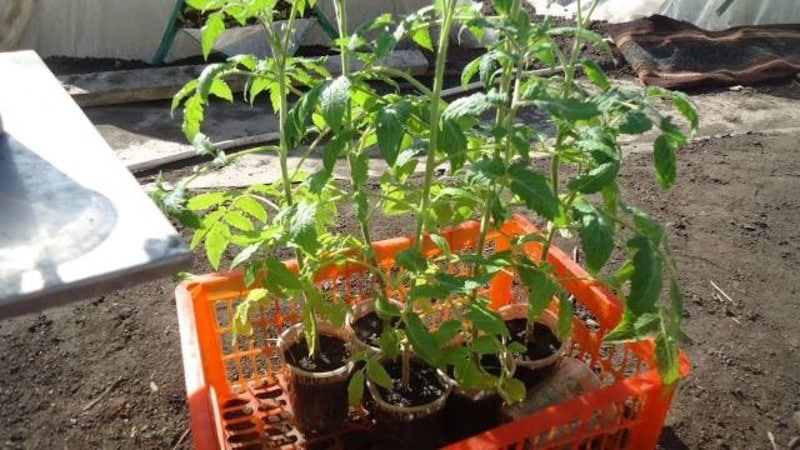
Sowing
Seeds are sown to a depth of 1.5-2 cm at a distance of 3 cm from each other. Then the soil is leveled from above and lightly moistened with a spray bottle. Planting containers are left in a warm and dark room at an air temperature of 22-24°C. Containers must be covered with film or glass to create a greenhouse effect.
Growing and care
When the first shoots appear, the containers are moved to a well-lit place. There should be at least 12 hours of daylight. In case of insufficient natural light, add phytolamps, which are installed at a distance of 30 cm from the seedlings.
Daytime temperature should not exceed 24°C, at night 18°C is sufficient. The room where it is located seedling, regularly ventilate, but protect from drafts, which have a detrimental effect on young plants.
Planting containers are watered with warm, settled water as the top layer of soil dries out using a shallow watering can along the edge of the nursery. After watering, the soil is loosened superficially so as not to damage the young roots.
When 2 true leaves appear, the seedlings are picked and placed in separate containers.
Reference. When sowing seeds in peat pots, picking is not required.
3 weeks before transplanting into the ground, seedlings begin to harden in order to quickly adapt to street conditions. To do this, young bushes are taken outside for 30 minutes - 1 hour in the daytime. The temperature in the room at night, where the seedlings are brought, is lowered to 13°C. Gradually, the time spent on the street is increased to 14 hours.
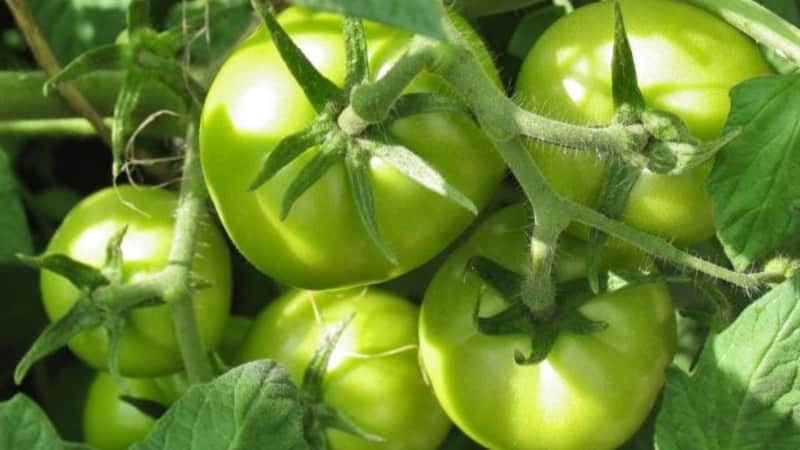
How to grow tomatoes
After 2 months, the seedlings are ready for transplanting. By this time, young plants reach a height of 25 cm, they have a fully developed root system and at least 6 true leaves.
Landing
A place for beds with tomatoes is chosen in the fall, taking into account what crops grew on the ground previously. Tomatoes are planted where legumes, melons, carrots or beets grew before them. Execution of rules crop rotation leads to maximum fruiting rate. The soil is fertilized with wood ash and humus.
In spring, the ground is loosened, removing weeds with roots, and holes are made 15 cm deep.
Planting pattern: 40 cm – distance between seedlings, 50 cm – between rows. For 1 sq. m place 4-5 plants in a checkerboard pattern. This method of planting provides maximum lighting and ventilation for young bushes.
The seedlings are transferred into the holes along with a lump of earth, sprinkled with soil and compacted. Then water abundantly and do not disturb the bushes for 2 weeks. During this time, tomatoes adapt to new conditions.
Tomato care Fatty
Regular watering is established as seedlings take root in open beds.Water only with warm, settled water, strictly at the root, without getting on the leaves. The water is pre-settled and heated in the sun in barrels. Before flowering begins, apply 5 liters of water under each tomato bush.
When forming buds, the amount of moisture is reduced to 3 liters, since excess leads to cracking of the fruit. Water at least 2 times a week. On hot and dry days, watering is increased up to 3-4 times as the soil dries out.
After each glaze the earth is loosened and hilled. This agricultural technique not only saturates the soil with oxygen, but also becomes a preventative measure in the fight against late blight and pests.
First feeding carried out 2 weeks after transplanting seedlings. Bird droppings (1:15) are well suited as fertilizer at this stage of development. But since the fertilizer contains nitrogen, it is not used in the future.
The second feeding is applied when the ovaries are forming. Feed with potassium-phosphorus fertilizer, for example, superphosphate and potassium sulfate (40 g of each fertilizer is dissolved in 10 liters of water). These microelements are also fed during the fruiting period.
Important! The culture responds well to the addition of organic matter. Universal fertilizer – wood ash. It is added to the water 2 days before watering.
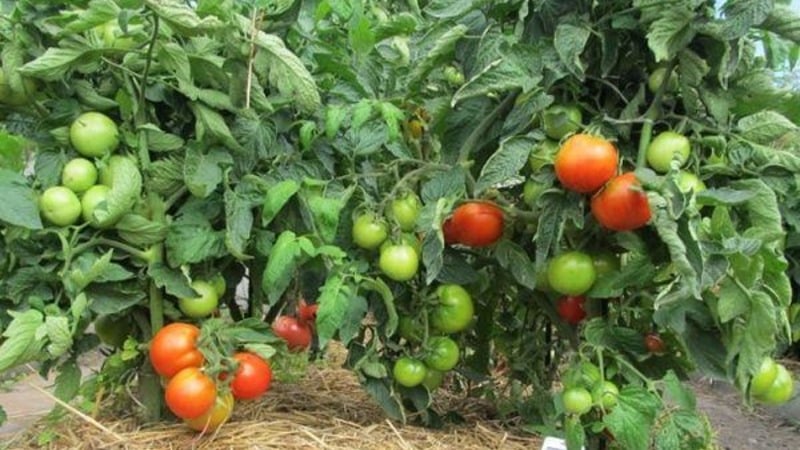
Features of cultivation and possible difficulties
Thanks to the small number of shoots, the bushes do not require regular pinching, which significantly simplifies care. But for a better quantitative indicator, plants are formed into 2 stems.
The crop cannot be done without a garter, otherwise the branches will not support the weight of ripe fruits. tied up as necessary to wooden or metal supports. This will not only protect the plants from damage, but will also simplify harvesting.
Diseases and pests
The culture has proven itself to be highly resistant to the main diseases of the Solanaceae family.
Preventive treatment of plants includes spraying with Bravo preparations or copper sulfate. “Bravo” is a contact fungicide and provides good protection against fungal diseases, for example, late blight. Copper sulfate also has the same effect.
Decoctions of onion peels and garlic (100 g per 1 liter, infuse for 1 day) save you from viruses and pests. The finished infusion is diluted with water 1:10 and sprayed on the plants. Many pests are repelled by strong odors and decoctions of strong-smelling herbs. Also, such herbs are planted next to tomatoes, and mustard bushes can even repel the Colorado potato beetle.
The nuances of growing in open ground and in a greenhouse
The variety is recommended for cultivation in protected and unprotected soil. The Fat Tomato takes root well in open beds in warm areas and in regions with a temperate climate. Where summers are short and cold, the crop is grown in greenhouses or under covering material.
It is recommended to regularly ventilate protected structures to avoid the spread of infections and pests. Greenhouse conditions are the most favorable for a pathogenic environment, which is destroyed by a regular influx of fresh air.
Experienced gardeners advise removing the lower leaves, otherwise they can cause late blight. When planting, it is necessary to avoid crowding of plants. Frequent planting not only reduces yields, but also leads to the spread of pests.
Harvesting and application
Ripening begins 90-95 days after the first shoots, but the period of the most abundant yield occurs on days 110-115 and lasts for another 2 weeks. Subsequent fruits weigh less than the first, so they can be used for whole-fruit canning.
Maturation in the hand is almost simultaneous, which simplifies collection. It is not necessary for all tomatoes to ripen completely; Tomatoes are also harvested when they are pink; they are quite capable of gaining color on their own at room temperature.
Harvesting vegetables earlier allows plants to lay down new fruiting clusters without becoming depleted.
The use of ripe vegetables is universal: They are used fresh, for pickling, marinades, canning, and are processed into tomato products. Tomatoes are good in summer salads, hot and vegetable dishes, baked with meat, and perfectly complement the taste of other vegetables. They make excellent juices, pastes, ketchups, adjika, and lecho. Vegetables do not lose their taste in pickles and marinades.
Thanks to their thick skin, tomatoes can be stored for a long time and can withstand long-term transportation without losing their appearance or taste.

Advantages and disadvantages of the variety
Tomato Fatty has many positive qualities:
- ease of care;
- immunity to diseases;
- ability to take root in any climatic conditions;
- does not require mandatory stepsoning;
- high fruiting rate;
- excellent taste of fruits;
- amicable maturation;
- universal use;
- long-term storage;
- long transportations.
The disadvantages of the culture include the obligatory garter.
Farmer reviews
Feedback from farmers is unanimous: everyone claims that the crop can take root and produce a good harvest in areas with harsh climatic conditions. This is an important factor for residents of the northern regions. Opinions of those who planted this variety:
Diana, Leningrad region: “I planted the fat one in a film greenhouse; when it gets cold, you can close it and not worry about the safety of the crop. The fruits were large, moderately dense, with aromatic and juicy pulp. The plant is low and takes up little space in the greenhouse. Maintenance is minimal: just watering and fertilizing. There’s no need to step-son.”
Alexander, Krasnoyarsk: “I am constantly in search of productive large-fruited tomatoes. I grow different species for sale. I really liked the Tolstushka tomatoes from the description and photographs, so I allocated a separate bed for them. The bushes are not tall, but the fruits are large and heavy. I collect 5-6 kg from a bush. I breed, of course, only in the greenhouse.”
Conclusion
Tomato Tolstushka is an indispensable variety for residents of northern regions who are deprived of the opportunity to pamper themselves with heat-loving vegetables. The variety is distinguished not only by its endurance and adaptability to unfavorable factors, but also by its high yield, immunity to many diseases and ease of care. This is an ideal option for experienced gardeners and beginners who want to get an excellent harvest without putting in a lot of effort.